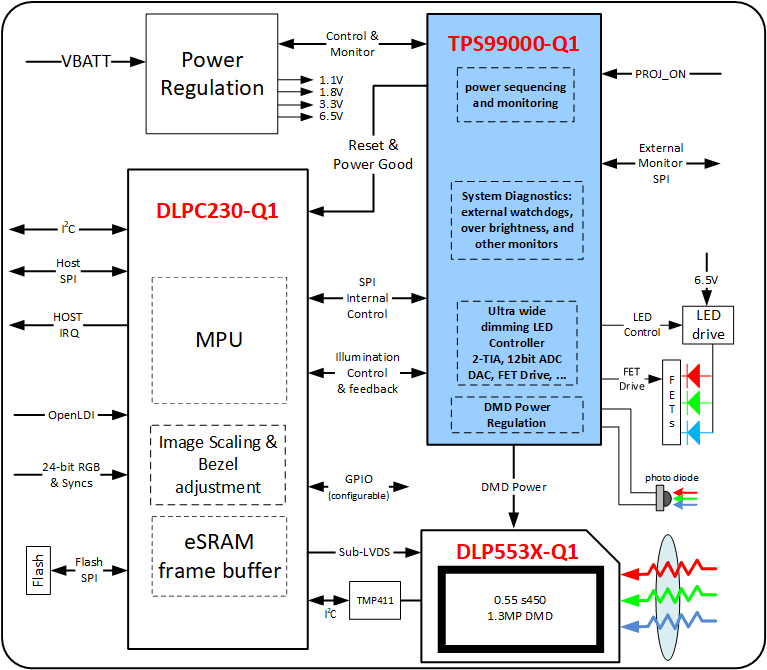ZHCSIF5F December 2015 – April 2019 TPS99000-Q1
PRODUCTION DATA.
- 1 特性
- 2 应用
- 3 说明
- 4 修订历史记录
- 5 Pin Configuration and Functions
-
6 Specifications
- 6.1 Absolute Maximum Ratings
- 6.2 ESD Ratings
- 6.3 Recommended Operating Conditions
- 6.4 Thermal Information
- 6.5 Electrical Characteristics - Transimpedance Amplifier Parameters
- 6.6 Electrical Characteristics - Digital to Analog Converters
- 6.7 Electrical Characteristics - Analog to Digital Converter
- 6.8 Electrical Characteristics - FET Gate Drivers
- 6.9 Electrical Characteristics - Photo Comparator
- 6.10 Electrical Characteristics - Voltage Regulators
- 6.11 Electrical Characteristics - Temperature and Voltage Monitors
- 6.12 Electrical Characteristics - Current Consumption
- 6.13 Power-Up Timing Requirements
- 6.14 Power-Down Timing Requirements
- 6.15 Timing Requirements - Sequencer Clock
- 6.16 Timing Requirements - Host / Diagnostic Port SPI Interface
- 6.17 Timing Requirements - ADC Interface
- 6.18 Switching Characteristics
-
7 Detailed Description
- 7.1 Overview
- 7.2 Functional Block Diagram
- 7.3
Feature Description
- 7.3.1
Illumination Control
- 7.3.1.1 Illumination System High Dynamic Range Dimming Overview
- 7.3.1.2 Illumination Control Loop
- 7.3.1.3 Continuous Mode Operation
- 7.3.1.4
Discontinuous Mode Operation
- 7.3.1.4.1 Discontinuous Mode Pulse Width Limit
- 7.3.1.4.2 COMPOUT_LOW Timer in Discontinuous Operation
- 7.3.1.4.3 Dimming Within Discontinuous Operation Range
- 7.3.1.4.4 Multiple Pulse Heights to Increase Bit Depth
- 7.3.1.4.5 TIA Gain Adjustment
- 7.3.1.4.6 Current Limit in Discontinuous Mode
- 7.3.1.4.7 CMODE Big Cap Mode in Discontinuous Operation
- 7.3.2 Over-Brightness Detection
- 7.3.3 Analog to Digital Converter
- 7.3.4 Power Sequencing and Monitoring
- 7.3.5 DMD Mirror Voltage Regulator
- 7.3.6 Low Dropout Regulators
- 7.3.7 System Monitoring Features
- 7.3.8 Communication Ports
- 7.3.1
Illumination Control
- 7.4 Device Functional Modes
- 7.5 Register Maps
- 8 Application and Implementation
- 9 Power Supply Recommendations
- 10Layout
- 11器件和文档支持
- 12机械、封装和可订购信息
封装选项
机械数据 (封装 | 引脚)
- PZP|100
散热焊盘机械数据 (封装 | 引脚)
- PZP|100
订购信息
3 说明
TPS99000-Q1 系统管理和照明控制器是 DLP553x-Q1 芯片组的组成部分,其中还包含 DLPC230-Q1 DMD 显示控制器。 该芯片组的亮度要求范围典型值为 3 至 15,000 尼特,具有严格的颜色点控制,能够为平视显示屏 (HUD) 应用提供支持所需的所有功能和超越典型 5000:1 显示器的调光要求。
集成式 DMD 高压稳压器电源可提供 DMD 镜像基准电压,满足严格容差的要求。电源序列发生器和监控器为整个芯片组的加电和断电事件提供可靠协同。
TPS99000-Q1照明控制器集成了一个 12 位 ADC、两个 DAC(12 位和 10 位)以及两个高性能光电二极管信号调节和跨阻放大器 (TIA),照明控制系统的核心组件之一。该 ADC 能够自动对每个视频帧进行高达 63 次事件采样。
先进的系统状态监控电路可提供实时图像,以显示子系统的运行情况,包括两个处理器看门狗电路、两个裸片温度监控器、用于过压和欠压检测的综合电源监控、在 SPI 总线事务上通过字节级奇偶校验获得的校验和以及密码寄存器保护、高亮监视器电路以及其他内置测试功能。
器件信息(1)
| 器件型号 | 封装 | 封装尺寸(标称值) |
|---|---|---|
| TPS99000-Q1 | HTQFP (100) | 14.00mm × 14.00mm |
- 如需了解所有可用封装,请参阅数据表末尾的可订购产品附录。
